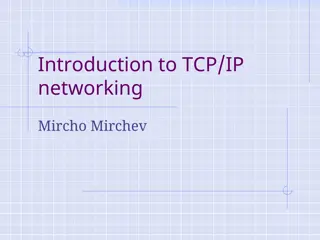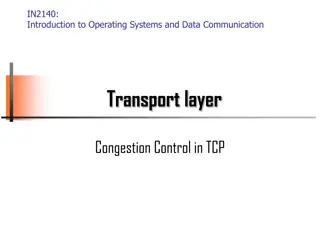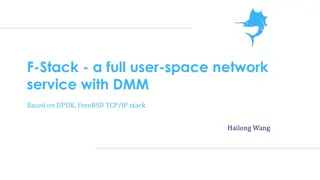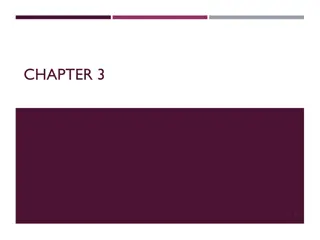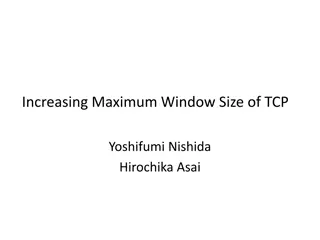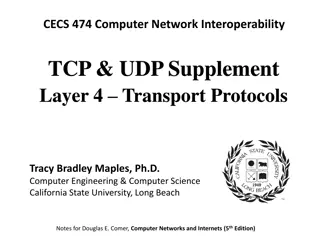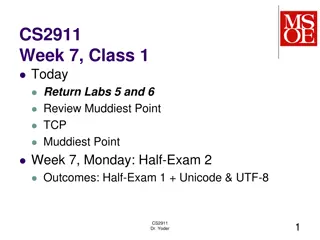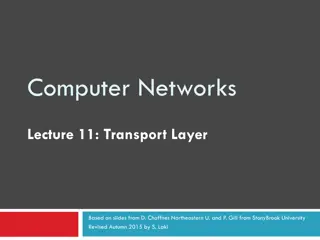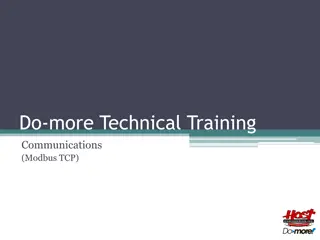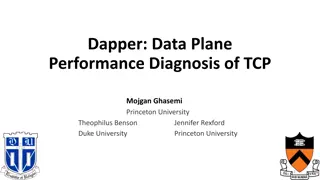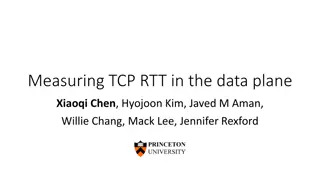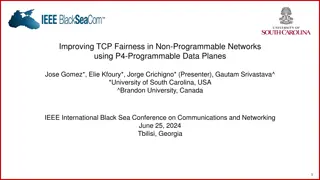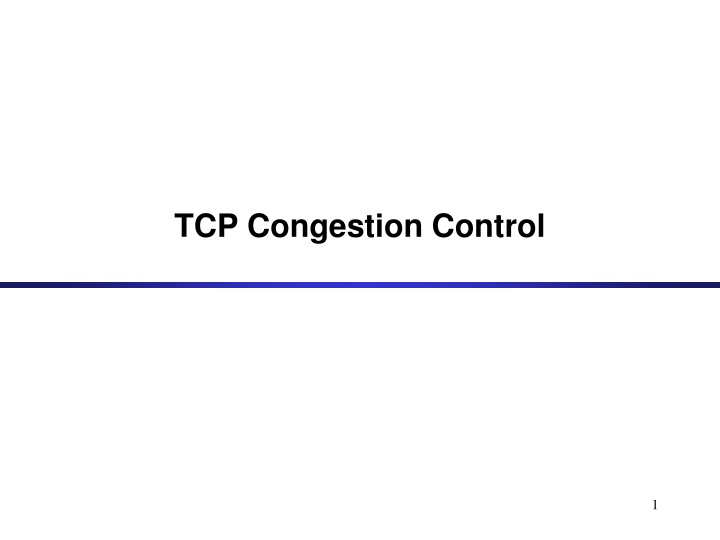
Understanding TCP Congestion Control Mechanisms
Learn about TCP congestion control which includes slow start, congestion avoidance, and additive increase/multiplicative decrease mechanisms. Explore how the congestion window (cwnd) and slow-start threshold value (ssthresh) influence data transmission efficiency in TCP connections.
Download Presentation

Please find below an Image/Link to download the presentation.
The content on the website is provided AS IS for your information and personal use only. It may not be sold, licensed, or shared on other websites without obtaining consent from the author. If you encounter any issues during the download, it is possible that the publisher has removed the file from their server.
You are allowed to download the files provided on this website for personal or commercial use, subject to the condition that they are used lawfully. All files are the property of their respective owners.
The content on the website is provided AS IS for your information and personal use only. It may not be sold, licensed, or shared on other websites without obtaining consent from the author.
E N D
Presentation Transcript
TCP Congestion Control TCP has binary congestion control: ACK received no congestion RTO Timeout congestion The mechanism is implemented at the sender by setting a congestion window The window size at the sender is set as follows: Send Window = MIN (flow control window, congestion window) where flow control window is advertised by the receiver congestion window is adjusted based on congestion information 2
TCP Congestion Control TCP congestion control is governed by two parameters: Congestion Window (cwnd) Slow-start threshhold Value (ssthresh) Initial value is advertised window Congestion control works in two modes: slow start (cwnd < ssthresh) congestion avoidance (cwnd ssthresh 3
Summary of TCP congestion control Initially: cwnd = 1; ssthresh = New Ack received: if (cwnd < ssthresh) /* Slow Start*/ cwnd = cwnd + 1; else /* Congestion Avoidance */ cwnd = cwnd + 1/cwnd; Timeout: /* Multiplicative decrease */ ssthresh = cwnd/2; cwnd = 1; advertised window size; Additive increase Multiplicative decrease 4
Slow Start Example The congestion window size grows very rapidly For every ACK, we increase cwnd by 1 irrespective of the number of segments ACK ed TCP slows down the increase of cwnd when cwnd > ssthresh segment 1 cwnd = 1 ACK for segment 1 cwnd = 2 segment 2 segment 3 ACK for segments 2 ACK for segments 3 cwnd = 4 segment 4 segment 5 segment 6 ACK for segments 4 ACK for segments 5 ACK for segments 6 cwnd = 7 5
Congestion Avoidance Congestion avoidance phase is started if cwnd has reached the slow-start threshold value If cwnd ssthresh then each time an ACK is received, increment cwnd as follows: cwnd = cwnd + 1/cwnd Then cwnd is (roughly) increased by one if all cwnd segments have been acknowledged. 6
Example of Slow Start/Congestion Avoidance Assume that ssthresh = 8 cwnd = 1 cwnd = 2 cwnd = 4 14 12 cwnd = 8 Cwnd (in segments) 10 ssthresh 8 6 4 cwnd = 9 2 0 t=0 t=2 Roundtrip times t=4 t=6 cwnd = 10 7
Responses to Congestion So, TCP assumes there is congestion if it detects a packet loss A TCP sender can detect lost packets via: Timeout of a retransmission timer Receipt of a duplicate ACK TCP interprets a Timeout as a binary congestion signal. When a timeout occurs, the sender performs: cwnd is reset to one: cwnd = 1 ssthresh is set to half the current size of the congestion window: ssthressh = cwnd / 2 and slow-start is entered 8
Summary of TCP congestion control Initially: cwnd = 1; ssthresh = New Ack received: if (cwnd < ssthresh) /* Slow Start*/ cwnd = cwnd + 1; else /* Congestion Avoidance */ cwnd = cwnd + 1/cwnd; Timeout: /* Multiplicative decrease */ ssthresh = cwnd/2; cwnd = 1; advertised window size; 9
Slow Start / Congestion Avoidance A plot of cwnd for a TCP connection (MSS = 1500 bytes) with slow start and congestion avoidance: 10
Flavors of TCP Congestion Control TCP Tahoe (1988, FreeBSD 4.3 Tahoe) Fast Retransmit TCP Reno (1990, FreeBSD 4.3 Reno) Fast Retransmit/ Fast Recovery New Reno (1996) BIC (2005) CUBIC (2008) Compound TCP or CTPC (2008) Based on estimates of queueing delays Linux and Mac Windows Many more: ECN, RED, Fast TCP 11
Acknowledgments in TCP Receiver sends ACK to sender ACK is used for flow control, error control, and congestion control ACK number sent is the next sequence number expected 1K SeqNo=0 AckNo=1024 1K SeqNo=1024 AckNo=2048 1K SeqNo=2048 1K SeqNo=3072 AckNo=2048 Lostsegment 12
Acknowledgments in TCP Receiver sends ACK to sender ACK is used for flow control, error control, and congestion control ACK number sent is the next sequence number expected 1K SeqNo=0 AckNo=1024 1K SeqNo=1024 AckNo=2048 1K SeqNo=2048 1K SeqNo=3072 AckNo=2048 Out-of-order arrivals 13
Fast Retransmit 1K SeqNo=0 If three or more duplicate ACKs are received in a row, the TCP sender believes that a segment has been lost. AckNo=1024 1K SeqNo=1024 1K SeqNo=2048 AckNo=1024 1. duplicate Then TCP performs a retransmission of what seems to be the missing segment, without waiting for a timeout to happen. 1K SeqNo=3072 AckNo=1024 2. duplicate 1K SeqNo=4096 AckNo=1024 Enter slow start: ssthresh = cwnd/2 cwnd = 1 3. duplicate 1K SeqNo=1024 1K SeqNo=5120 14
Fast Retransmit / Fast Recovery cwnd=12 sshtresh=5 1K SeqNo=0 Fast recovery avoids slow start after a fast retransmit AckNo=1024 cwnd=12 sshtresh=5 1K SeqNo=1024 Intuition: Duplicate ACKs indicate that data is getting through 1K SeqNo=2048 After three duplicate ACKs set: Retransmit packet that is presumed lost ssthresh = cwnd/2 cwnd = ssthresh+3 (note the order of operations) Increment cwnd by one for each additional duplicate ACK AckNo=1024 1. duplicate cwnd=12 sshtresh=5 1K SeqNo=3072 AckNo=1024 2. duplicate cwnd=12 sshtresh=5 1K SeqNo=4096 AckNo=1024 3. duplicate cwnd=9 sshtresh=6 1K SeqNo=1024 When ACK arrives that acknowledges new data (here: AckNo=6148), set: cwnd=ssthresh enter congestion avoidance 1K SeqNo=5120 ACK for new data cwnd=6 sshtresh=6 AckNo=6148 15
TCP Reno Duplicate ACKs: Fast retransmit Fast recovery Fast Recovery avoids slow start Timeout: Retransmit Slow Start TCP Reno improves upon TCP Tahoe when a single packet is dropped in a round-trip time. 16
TCP Tahoe and TCP Reno (for single segment losses) cwnd Taho time Reno cwnd time 17



